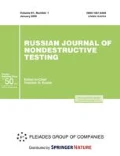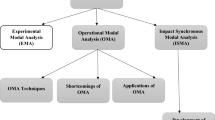Abstract
The high reliability of modern 3D printing technologies makes it possible to create structural elements for aerospace and rocket industry products. Currently, the team of authors are developing a system for designing and additive manufacturing of composite and polymer structures for high-tech applications. In this paper, we studied the body of a Tomsk-TPU-120 CubSat satellite, the first Russian spacecraft to contain additive manufactured elements. Device quality control was carried out using resonant ultrasonic stimulation in conjunction with the use of scanning Doppler laser vibrometry, as well as experimental modal analysis. The testing results made it possible to reveal a defect at the butt end surface of the satellite body by analyzing the amplitude-frequency characteristic of surface vibrations. Experimental vibration-scanning data were used to verify a mathematical model developed using the ANSYS software.




Similar content being viewed by others
REFERENCES
Brian, E., Practical 3D Printers—the Science and Art of 3D Printing, New York: Apress, 2012.
Huber, C., Abert, C., Bruckner, F., et al., 3D print of polymer bonded rare-earth magnets, and 3D magnetic field scanning with an end-user 3D printer, Appl. Phys. Lett., 2016, vol. 109, no. 16, article no. 162401. https://doi.org/10.1063/1.4964856
Goh, G.D., Agarwala, S., Goh, G.L., Dikshit, V., Sing, S.L., and Yeong, W.Y., Additive manufacturing in unmanned aerial vehicles (UAVs): Challenges and potential, Aerosp. Sci. Technol., 2017, vol. 63, pp. 140–151.
Cranston, B., AIGhofaily, M., and Palazotto, A., Design and structural analysis of unique structures under an internal vacuum, Aerosp. Sci. Technol., 2017, vol. 68, pp. 68–76. https://doi.org/10.1016/j.ast.2017.04.028
Rego, I.S, Marcos, T.V.C., Pinto, D.R., et al., Ground experimentation with 3D printed scramjet inlet models at hypervelocities, Aerosp. Sci. Technol., 2016, vol. 55, pp. 307–313. https://doi.org/10.1016/j.ast.2016.06.009
Wang, P., Tan, X., He, C., Nai, M.L.S., Huang, R., Tor, S.B., and Wei, J., Scanning optical microscopy for porosity quantification of additively manufactured components, Addit. Manuf., 2018, vol. 21, pp. 350–358. https://doi.org/10.1016/j.addma.2018.03.019
Simonetti, F., Satow, I.L., Brath, A.J., Wells, K.C., Porter, J., Hayes, B., and Davis, K., Cryo-ultrasonic NDE: ice-cold ultrasonic waves for the detection of damage in complex-shaped engineering components, IEEE Trans. Ultrason. Eng., 2018, vol. 65, pp. 638–647. https://doi.org/10.1109/TUFFC.2018.2796387
Dao, P.B., Klepka, A., Pieczonka, Ł., Aymerich, F., and Staszewski, W.J., Impact damage detection in smart composites using nonlinear acoustics–cointegration analysis for removal of undesired load effect, Smart Mater. Struct., 2017, vol. 26, article no. 035012.
Fierro, G., Calla, D., Ginzburg, D., Ciampa, F., and Meo, M., Nonlinear ultrasonic stimulated thermography for damage assessment in isotropic fatigued structures, J. Sound Vib., 2017, vol. 404, pp. 102–115. https://doi.org/10.1016/j.jsv.2017.05.041
Solodov, I., Resonant vibration nonlinearity in acoustic wave-defect interaction, AIP Conf. Proc. 1685, 2015, article no. 020003.
Derusova, D.A., Vavilov, V.P., Guo, X., and Druzhinin, N.V., Comparing the efficiency of ultrasonic infrared thermography under high-power and resonant stimulation of impact damage in a CFRP composite, Russ. J. Nondestr. Test., 2018, vol. 54, no. 5, pp. 356—362. https://doi.org/10.1134/S1061830918050030
Xiamen Dynachem Import & Export Trading Co.,Ltd, 2017 (accessed December 13, 2017).
Bendat, J.S. and Piersol, A.G., Random Data: Analysis and Measurement Procedures, Wiley, 2012. 4th Ed.
ANSYS® Mechanical APDL, Release 16.1, Help System, Structural Analysis Guide, ANSYS, Inc.
Solodov, I., Pfleiderer, K., Gerhard, H., Predak, S., and Busse, G., New opportunities for NDE with air-coupled ultrasound, NDT & E Int., 2006, vol. 39, pp. 176–183. https://doi.org/10.1016/j.ndteint.2005.07.002
Solodov, I., Resonant acoustic nonlinearity of defects for highly-efficient nonlinear NDE, J. Nondestr. Eval., 2014, vol. 33, pp. 252–262. https://doi.org/10.1007/s10921-014-0229-9
Hettler, J., Tabatabaeipour, M., Delrue, S., and Van Den Abeele, K., Detection and characterization of local defect resonances arising from delaminations and flat bottom holes, J. Nondestr. Eval., 2017, vol. 3, article no. 2. https://doi.org/10.1007/s10921-016-0380-6
Krasnoveikin, V.A., Smolin, I.Y., Druzhinin, N.V., Kolubaev, E.A., and Derusova, D.A., Modal testing circuit board assembly of an electronic apparatus by laser vibrometry, IOP Conf. Ser: Mater. Sci. Eng., 2016, vol. 156. article no. 012005. https://doi.org/10.1088/1757-899X/156/1/012005
Rahammer, M. and Kreutzbruck, M., Fourier-transform vibrothermography with frequency sweep excitation utilizing local defect resonances, NDT & E Int., 2017, vol. 86, pp. 83–86. https://doi.org/10.1016/j.ndteint.2016.11.012
Vavilov, V., Chulkov, A., and Derusova, D., IR thermographic characterization of low energy impact damage in carbon/carbon composite by applying optical and ultrasonic stimulation, Proc. SPIE, Int. Soc. Opt. Eng., 2014, vol. 9105, pp. 1–9. https://doi.org/10.1016/j.polymertesting.2016.07.023
Vavilov, V., Marinetti, S., Pan, Y., and Chulkov, A., Detecting water ingress in aviation honeycomb panels: qualitative and quantitative aspects, Polym. Test., 2016, vol. 54, pp. 270–280.
Funding
The methodolody of resonance ultrasonic vibrometry and experimental results (section 3.2) was done at Tomsk Polytechnic University by D.A. Derusova, V.Yu. Shpil’noi and supported by Russian Science Foundation under grant no. 18-79-00029. Introduction, Section 1 and Section 2 of this article were done with the support of the Tomsk Polytechnic University Competitiveness Enhancement Program. Experimental results (section 3.1) was done by the Fundamental Research Program of the State Academies of Sciences for 2013-2020, line of research III.23.
Author information
Authors and Affiliations
Corresponding author
Additional information
Translated by V. Potapchouck
Rights and permissions
About this article
Cite this article
Derusova, D.A., Vavilov, V.P., Druzhinin, N.V. et al. Nondestructive Testing of CubSat Satellite Body Using Laser Vibrometry. Russ J Nondestruct Test 55, 418–425 (2019). https://doi.org/10.1134/S1061830919050024
Received:
Revised:
Accepted:
Published:
Issue Date:
DOI: https://doi.org/10.1134/S1061830919050024




